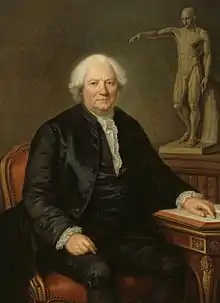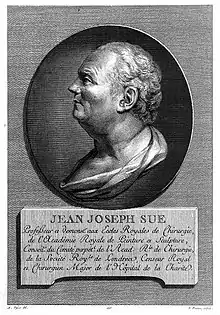Jean-Joseph Sue
Prof Jean-Joseph Sue FRS FRSE (April 20, 1710–December 15, 1792) was a French surgeon and anatomist.

Life
He was born at La Colle-sur-Loup on 20 April 1710[1] the son of Pierre Jean Sue (d.1714) and his wife, Marguerite Bellisime (d.1748).
Jean-Joseph Sue was a professor at the Collège Royal de Chirurgie and the Académie de peinture et de sculpture. He was the author of numerous treatises on anatomy and surgery, and is credited with the creation of approximately 200 anatomical plates.
In 1750 he published "Anthropotomie ou l'Art de disséquer", a book that is considered to be a classic work on androtomy (the art of dissection). Another important work by Sue was "Traité d'Ostéologie", which was a translation of Alexander Munro's treatise "Anatomy of the Bones". This translation is known for its exquisite, masterful engravings.
He was elected a Fellow of the Royal Society in 1760[2] and was a Foreign Founding Member of the Royal Society of Edinburgh in 1783.[3]
He died in Paris on 15 December 1792, aged 82.[4]

Family
He married Jeanne Angelique Martin de Martin.[5]
His youngest son, also named Jean-Joseph Sue (1760–1830), was a noted anatomist and the grandfather of novelist Eugene Sue (1804–1857).
His eldest son, Pierre Sue FRSE (1739-1816) was also an anatomist.
References
- Biographical Index of Former Fellows of the Royal Society of Edinburgh 1783–2002 (PDF). The Royal Society of Edinburgh. July 2006. ISBN 0-902-198-84-X.
- "Fellows Details". Royal Society. Retrieved 15 January 2017.
- Biographical Index of Former Fellows of the Royal Society of Edinburgh 1783–2002 (PDF). The Royal Society of Edinburgh. July 2006. ISBN 0-902-198-84-X.
- https://www.geni.com/people/Jean-Joseph-Sue/6000000021096624643
- https://www.geni.com/people/Jeanne-Ang%C3%A9lique-S%C3%BCe/6000000077762741519
- Parts of this article are based on a translation of an equivalent article at the French Wikipedia.
- ILAB, Description of "Traité d'Ostéologie"